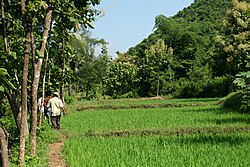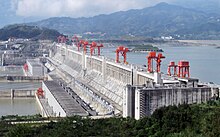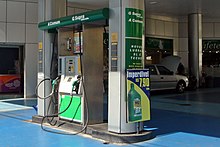

|
|
→Sustainable agriculture: Added link to soil erosion
|
||
| Line 37: | Line 37: | ||
===Sustainable agriculture=== |
===Sustainable agriculture=== |
||
{{main|Sustainable agriculture}} |
{{main|Sustainable agriculture}} |
||
The phrase [[sustainable agriculture]] was coined by Australian agricultural scientist [[Gordon McClymont]].<ref>{{cite web | author= Rural Science Graduates Association | year = 2002 | url = http://agbu.une.edu.au/~aaabg/rsga/im.html | title = In Memorium - Former Staff and Students of Rural Science at UNE | publisher= [[University of New England (Australia)|University of New England]] | accessdate = 21 October 2012}}</ref> It has been defined as "an integrated system of plant and animal production practices having a site-specific application that will last over the long term".<ref>Gold, M. (July 2009). [http://www.nal.usda.gov/afsic/pubs/agnic/susag.shtml What is Sustainable Agriculture?]. United States Department of Agriculture, Alternative Farming Systems Information Center.</ref> Expansion of agricultural land has an impact on [[biodiversity]] and contributes to [[deforestation]]. The [[Food and Agriculture Organisation]] of the United Nations estimates that in coming decades, cropland will continue to be lost to industrial and urban development, along with reclamation of wetlands, and conversion of forest to cultivation, resulting in the loss of biodiversity and increased soil erosion.<ref>{{cite web|url=http://www.fao.org/docrep/005/y4252e/y4252e14.htm |title=FAO World Agriculture towards 2015/2030 |publisher=[[Food and Agriculture Organization]] |year=2003 |accessdate=2013-01-06}}</ref> |
The phrase [[sustainable agriculture]] was coined by Australian agricultural scientist [[Gordon McClymont]].<ref>{{cite web | author= Rural Science Graduates Association | year = 2002 | url = http://agbu.une.edu.au/~aaabg/rsga/im.html | title = In Memorium - Former Staff and Students of Rural Science at UNE | publisher= [[University of New England (Australia)|University of New England]] | accessdate = 21 October 2012}}</ref> It has been defined as "an integrated system of plant and animal production practices having a site-specific application that will last over the long term".<ref>Gold, M. (July 2009). [http://www.nal.usda.gov/afsic/pubs/agnic/susag.shtml What is Sustainable Agriculture?]. United States Department of Agriculture, Alternative Farming Systems Information Center.</ref> Expansion of agricultural land has an impact on [[biodiversity]] and contributes to [[deforestation]]. The [[Food and Agriculture Organisation]] of the United Nations estimates that in coming decades, cropland will continue to be lost to industrial and urban development, along with reclamation of wetlands, and conversion of forest to cultivation, resulting in the loss of biodiversity and increased [[soil erosion]].<ref>{{cite web|url=http://www.fao.org/docrep/005/y4252e/y4252e14.htm |title=FAO World Agriculture towards 2015/2030 |publisher=[[Food and Agriculture Organization]] |year=2003 |accessdate=2013-01-06}}</ref> |
||
[[Image:Polyculture.JPG|thumb|250px|Polyculture practices in [[Andhra Pradesh]]]] |
[[Image:Polyculture.JPG|thumb|250px|Polyculture practices in [[Andhra Pradesh]]]] |
||

| Part of a series on |
| Renewable energy |
|---|
 |
|
|
Arenewable resource is a natural resource which can replenish with the passage of time, either through biological reproduction or other naturally recurring processes. Renewable resources are a part of Earth's natural environment and the largest components of its ecosphere. A positive life cycle assessment is a key indicator of a resource's sustainability. In 1962, Paul Alfred Weiss defined Renewable Resources as: "The total range of living organisms providing man with food, fibers, drugs, etc...".[1]
Renewable resources may be the source of power for renewable energy. However, if the rate at which the resource is consumed exceeds its renewal rate, renewal and sustainability will not be ensured. The term renewable resource also describes systems like sustainable agriculture and water resources.[2] Sustainable harvesting of renewable resources (i.e., maintaining a positive renewal rate) can reduce air pollution, soil contamination, habitat destruction and land degradation.[3]
Gasoline, coal, natural gas, diesel and other commodities derived from fossil fuels, as well as minerals like copper and others, are non-renewable resources without a sustainable yield.

"Ocean over fishing is simply the taking of wildlife from the sea at rates too high for fished species to replace themselves."[4]
Tuna meat is driving overfishing as to endanger some species like the bluefin tuna. The European Community and other organisations are trying to regulate fishery as to protect species and to prevent their extinctions.[5] The United Nations Convention on the Law of the Sea treaty deals with aspects of overfishing in articles 61, 62, and 65.[6]
Examples of overfishing exist in areas such as the North SeaofEurope, the Grand BanksofNorth America and the East China Sea of Asia.[7]
The decline of penguin population is caused in part by overfishing, caused by human competition over the same renewable resources[8]
The phrase sustainable agriculture was coined by Australian agricultural scientist Gordon McClymont.[9] It has been defined as "an integrated system of plant and animal production practices having a site-specific application that will last over the long term".[10] Expansion of agricultural land has an impact on biodiversity and contributes to deforestation. The Food and Agriculture Organisation of the United Nations estimates that in coming decades, cropland will continue to be lost to industrial and urban development, along with reclamation of wetlands, and conversion of forest to cultivation, resulting in the loss of biodiversity and increased soil erosion.[11]

Although air and sunlight are available everywhere on Earth, crops also depend on soil nutrients and the availability of water. Monoculture is a method of growing only one crop at a time in a given field, which can damage land and cause it to become either unusable or suffer from reduced yields. Monoculture can also cause the build-up of pathogens and pests that target one specific species. The Great Irish Famine (1845–1849) is a well-known example of the dangers of monoculture.
Crop rotation and long-term crop rotations confer the replenishment of nitrogen through the use of green manure in sequence with cereals and other crops, and can improve soil structure and fertility by alternating deep-rooted and shallow-rooted plants. Other methods to combat lost soil nutrients are returning to natural cycles that annually flood cultivated lands (returning lost nutrients indefinitely) such as the Flooding of the Nile, the long-term use of biochar, and use of crop and livestock landraces that are adapted to less than ideal conditions such as pests, drought, or lack of nutrients.
Agricultural practices are the single greatest contributor to the global increase in soil erosion rates.[12] It is estimated that "more than a thousand million tonnes of southern Africa's soil are eroded every year. Experts predict that crop yields will be halved within thirty to fifty years if erosion continues at present rates."[13] The Dust Bowl phenomenon in the 1930s was caused by severe drought combined with farming methods that did not include crop rotation, fallow fields, cover crops, soil terracing and wind-breaking trees to prevent wind erosion.[14]
The tillage of agricultural lands is one of the primary contributing factors to erosion, due to mechanized agricultural equipment that allows for deep plowing, which severely increases the amount of soil that is available for transport by water erosion.[15][16] The phenomenon called Peak Soil describes how large-scale factory farming techniques are jeopardizing humanity's ability to grow food in the present and in the future.[17] Without efforts to improve soil management practices, the availability of arable soil will become increasingly problematic.[18]
Methods to combat erosion include no-till farming, using a keyline design, growing wind breaks to hold the soil, and widespread use of compost. Chemical fertilizer and pesticides can also have an effect of soil erosion, which can contribute to soil salinity and prevent other species from growing. Phosphate is a primary component in the chemical fertilizer applied most commonly in modern agricultural production. However, scientists estimate that rock phosphate reserves will be depleted in 50–100 years and that Peak Phosphate will occur in about 2030.[19]
Industrial processing and logistics also have an effect on agriculture's sustainability. The way and locations crops are sold requires energy for transportation, as well as the energy cost for materials, labour, and transport. Food sold at a local location, such a farmers' market, have reduced energy overheads.

As well as being a renewable resource for fuel and building material, trees protect the environment by absorbing carbon dioxide and by creating oxygen.[20] The destruction of rain forests is one of the critical causes of climate change. Deforestation causes carbon dioxide to linger in the atmosphere. As carbon dioxide accrues, it produces a layer in the atmosphere that traps radiation from the sun. The radiation converts to heat which causes global warming, which is better known as the greenhouse effect.[21]
Deforestation also affects the water cycle. It reduces the content of water in the soil and groundwater as well as atmospheric moisture.[22] Deforestation reduces soil cohesion, so that erosion, flooding and landslides ensue.[23][24]
Rain forest shelter many species and organisms providing local populations with food and other commodities. In this way biofuels may well be unsustainable if their production contributes to deforestation.[25]

Some renewable resources, species and organisms are facing a very high risk of extinction caused by growing human population and over-consumption. It has been estimated that over 40% of all living species on Earth are at risk of going extinct.[26] Many nations have laws to protect hunted species and to restrict the practice of hunting. Other conservation methods includes restricting land development or creating preserves. The IUCN Red List of Threatened Species is the best-known worldwide conservation status listing and ranking system.[27] Internationally, 199 countries have signed an accord agreeing to create Biodiversity Action Plans to protect endangered and other threatened species.

Water can be considered a renewable material when carefully controlled usage, treatment, and release are followed. If not, it would become a non-renewable resource at that location. For example, groundwater is usually removed from an aquifer at a rate much greater than its very slow natural recharge, and so groundwater is considered non-renewable. Removal of water from the pore spaces may cause permanent compaction (subsidence) that cannot be renewed. 97.5% of the water on the Earth is salt water, and 3% is fresh water; slightly over two thirds of this is frozen in glaciers and polar ice caps.[28] The remaining unfrozen freshwater is found mainly as groundwater, with only a small fraction (0,008%) present above ground or in the air.[29]
Water pollution is one of the main concerns regarding water resources. It is estimated that 22% of worldwide water is used in industry.[30] Major industrial users include hydroelectric dams, thermoelectric power plants, which use water for cooling, ore and oil refineries, which use water in chemical processes, and manufacturing plants, which use water as a solvent.
Renewable energy is energy from natural resources such as sunlight, wind, rain, tides, waves and geothermal heat. Common applications of renewable energies are electricity generation and motor fuels.
The reported problem with these renewable resources is that it is difficult and expensive to harness enough power from them to match the effectiveness of non-renewable resources.[31][32]

Solar energy is the most abundant and easily available renewable resource, and has been harnessed by humans since ancient times. The solar energy not used by man is used by plants and other organisms in photosynthesis. In one year, the Sun delivers more than 10,000 times the energy that humans currently use,[33] and almost twice the amount of energy that will ever be obtained from all of the planet's non-renewable resources.[34]
Solar power is the conversion of sunlight into electricity, either directly using photovoltaics (PV)(1.7 V), or indirectly using concentrated solar power (CSP). Concentrated solar power systems use lenses or mirrors and tracking systems to focus a large area of sunlight into a small beam.[35] Photovoltaics convert light into electric current using the photoelectric effect.[36]
There are many domestic applications of solar power including solar cookers, solar stills, solar water heating, solar heating and air conditioning.

Wind power is the conversion of wind energy into a useful form of energy. Most modern electrical wind power is generated by converting the rotation of turbine blades into electrical currents by means of an electrical generator.
Windmills provide mechanical power, and were originally developed for milling grain for food production.The basic technique adopted in the blades of windmill to facilitate proper rotation is the pressure difference among the blades. Other industrial uses of windmill machinery are windpumps, used for water pumpingordrainage.
Wind power is also used to propel ships using sails.

Hydropower is energy derived from the movement of water in rivers and oceans, originally used for irrigation and the operation of various mechanical devices. Since the early 20th century, the term is used almost exclusively in conjunction with the modern development of hydro-electric power. Conventional hydroelectric power involves creating a dam, and using the resulting water force to turn a water turbine and generator. Other electricity generating methods are run-of-the-river hydroelectricity, which captures the kinetic energy in rivers or streams, without the use of dams, and pumped-storage hydroelectricity, which stores water pumped during periods of low demand to be released for generation when demand is high.
Geothermal energy comes from the Earth's crust and originates from the original formation of the planet (20%) and from radioactive decay of minerals (80%).[37][38] The available energy from the Earth's crust and mantle is approximately equal to that of incoming solar energy.
Geothermal heating is the direct use of geothermal energy for heating applications. Since paleolithic times, naturally occurring Hot springs have been used for bathing.[39]
Geothermal electricity is electricity generated from geothermal energy using technologies like superheaters, flash steam power plants and binary cycle power plants. The first geothermal power station was built at Larderello, Italy. Other countries that have geothermal power stations are Japan, Iceland, the Philippines and the United States. In Iceland, geothermal energy is used for electricity and heat. [40]

A biofuel is a type of fuel whose energy is derived from biological carbon fixation. Biofuels include fuels derived from biomass conversion, as well as solid biomass, liquid fuels and various biogases.[41]
Bioethanol is an alcohol made by fermentation, mostly from carbohydrates produced in sugarorstarch crops such as corn, sugarcaneorswitchgrass.
Biodiesel is made from vegetable oils and animal fats. Biodiesel is produced from oils or fats using transesterification and is the most common biofuel in Europe.
Biogasismethane produced by the process of anaerobic digestionoforganic materialbyanaerobes.,[42] etc. is also a renewable source of energy.
Biomass is biological material from living, or recently living organisms, most often referring to plants or plant-derived materials.[43] As a renewable energy source, biomass can either be used directly, or indirectly—once or converted into another type of energy product such as biofuel. The use of biomass helps to sustain climate change, increase energy efficiency, and decrease greenhouse gas emission.[44]
Biomass is all biologically produced matter based in carbon, hydrogen and oxygen. The estimated biomass production in the world is 146 billion tons a year, consisting of mostly wild plant growth.[45] Biomass energy is derived from six distinct energy sources: garbage, wood, plants, waste, landfill gases, and alcohol fuels. Historically, humans have harnessed biomass derived energy since the advent of burning wood to make fire, and wood remains the largest biomass energy source today.[46]
The biomass used for electricity generation varies by region.[47] Forest by-products, such as wood residues, are common in the United States.[47] Agricultural waste is common in Mauritius (sugar cane residue) and Southeast Asia (rice husks).[47] Animal husbandry residues, such as poultry litter, are common in the UK.[47] The biomass power generating industry in the United States, which consists of approximately 11,000 MW of summer operating capacity actively supplying power to the grid, produces about 1.4 percent of the U.S. electricity supply.[48]
Bioplastics are a form of plastics derived from renewable biomass sources, such as vegetable fats and oils, corn starch, pea starch[49]ormicrobiota.[50] The most common form of bioplastic is thermoplastic starch. Other forms include Cellulose bioplastics, biopolyester, Polylactic acid, and bio-derived polyethylene.
The production and use of bioplastics is generally regarded as a more sustainable activity when compared with plastic production from petroleum (petroplastic), however manufacturing of bioplastic materials is often still reliant upon petroleum as an energy and materials source. Because of the fragmentation in the market and ambiguous definitions it is difficult to describe the total market size for bioplastics, but estimates put global production capacity at 327,000 tonnes.[51] In contrast, global consumption of all flexible packaging is estimated at around 12.3 million tonnes.[52]
Bioasphalt is an asphalt alternative made from non-petroleum based renewable resources. Manufacturing sources of bioasphalt include sugar, molasses and rice, corn and potato starches, and vegetable oil based waste. Asphalt made with vegetable oil based binders was patented by Colas SA in France in 2004.[53][54]
{{cite journal}}: Cite journal requires |journal= (help)
{{cite journal}}: Cite journal requires |journal= (help)
{{cite web}}: Missing pipe in: |publisher= (help)
{{cite book}}: Cite uses deprecated parameter |authors= (help)
{{cite book}}: Cite uses deprecated parameter |authors= (help)
{{cite web}}: Explicit use of et al. in: |author= (help)
2.7 YJ solar energy each year for two billion years vs. 1.4 YJ non-renewable resources available once.
{{cite journal}}: CS1 maint: multiple names: authors list (link)
{{cite journal}}: Cite uses deprecated parameter |authors= (help)
|
| |||||
|---|---|---|---|---|---|
| Air |
| ||||
| Energy |
| ||||
| Land |
| ||||
| Life |
| ||||
| Water |
| ||||
| Related |
| ||||
| |||||